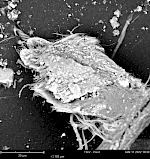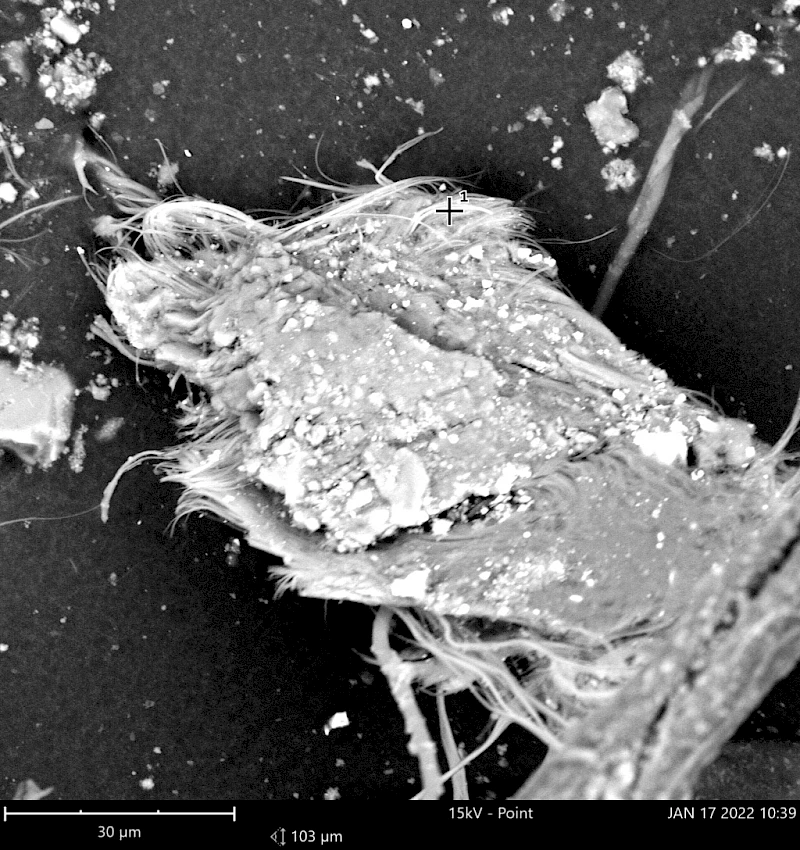Abstract
The basis for this contribution is the essay, “Toxic Leftovers of Collecting” (Caviezel 2022: 69-78), which deals with the processes involved in decontaminating asbestos-contaminated vintage cars in a Swiss foundation’s collection. Extending the body of research to its relational contexts of more-than-human ecologies, this contribution focuses on asbestos and rubber components that contain asbestos, both of which are built into vintage cars. Following the traces of these materials offers insight into the post-/colonial entanglements of the mining, processing, and trading industries. Tracing as a practice of artistic research addresses the fragmentary nature of those transnational ecologies and the emerging multivocal, multilocal, and multisensory narratives by spinning mental networks between the multifaceted fragments connected to the collection objects.
Preface
In 2021, I conducted audiovisual research published under the title Toxic Leftovers of Collecting (Caviezel 2022: 69-78).1 The work focused on the cleaning and transformation processes of asbestos-contaminated vintage cars belonging to the collection of a Swiss foundation. Conservation was viewed from a dual perspective: the maintenance operations that the collection requires, and the human-material entanglements that these operations entail. Drawing on the broad framework of New Materialism, I elaborated an image-based essay that outlines the balancing act between preservation and elimination, restoration, remediation, and disposal that confront collections with contentious or toxic materials today. These handling practices require a deepened examination of the dangers caused by pollutants built into objects or added later by conservation treatments. Awareness of the toxic agency of these materials and vestiges of any treatments has greatly affected the everyday practice of conservation. The essay aimed to contribute to the increasing focus on chemical contamination and toxicity since the 1990s, and to the ecological and political relevance of objects and materials, which also applies to the field of collections.
This essay continues and extends my research by exploring more amply the relational contexts of more-than-human ecologies in the context of object production and conservation. It focuses particularly on asbestos and rubber components containing asbestos built into vintage cars as well as their traces in time and space. The study will reach beyond the closed circuit of foundation and museum collections and examine the connections of the material composition of the exhibits across history. It will offer insight into the post-/colonial entanglements of the material’s mining, processing, and trading, and the inscribed transnational implications. Also, I want to complicate the notion of conservation by including extended material tracings of (invisible) components contained in collections that can considerably alter the understanding of global interdependencies. The vintage cars in the Swiss collection are connected to global mining and industrial production networks structured by race, class, and gender dimensions.
My geographical focus is the USA, as it is the pivot of the relevant companies’ business activities. Of special interest are the production chains of the Stanley Steamer Roadster, a classic car constructed in 1906 by the Stanley Motor Carriage Company in Watertown, New York.
Rather than write an exhaustive history of these material entanglements, I shall resort to tracing as a methodological approach, creating a fragmentary narrative. As a practice of artistic research, tracing addresses the fragmentary non-linear character of the transnational ecologies and their emerging multivocal, multilocal, and multisensory narratives by weaving mental networks between the multifaceted fragments which are linked to the collection objects.2 The essay combines audiovisual and textual research material. Images, sounds, words, sensations, information, and analytical commentary are juxtaposed to create different layers of perception and reception. My essay attempts to promote the societal transformations necessary beyond the field of heritage conservation. From analysis of the economic, social, and ecological conditions of the extraction and production processes of materials and objects, we can build a more responsible relationship towards objects, an epistemological shift from the German “ent-sorgen”/discarding (literally “dis-caring”), to ‘sorgen”/caring.
2 - I refer to the prior research project Times of Waste (https://times-of-waste.ch) and its online archive, the Smartphone Object Biography (https://objektbiografie.times-of-waste.ch/en/) developed by a research team including myself (PI), Mirjam Bürgin, Anselm Caminada, Adrian Demleitner, Marion Mertens, Yvonne Volkart, and Sonia Malpeso. ↩
Acknowledgement
My sincere thanks go to all who contributed to the writing of this essay, especially Lotte Arndt and Noémie Etienne for their support in conceptualizing the article and providing feedback for early versions; Mirjam Bürgin and Marion Mertens (Handle with Care research team) for subject-specific discussions on toxicity issues; the Stiftung für Kunst, Kultur und Geschichte (SKKG), Bafob and the Analysis Lab Bern for consenting to the re-publication of images of the vintage car’s decontamination; the Library of Congress for access to the movie The Story of Asbestos; the editorial team, and the reviewer for their careful editorial work.
BibliographieBibliography +
Arjun Appadurai, “Introduction. Commodities and the politics of value”, in Arjun Appadurai, The Social Life of Things. Commodities in Cultural Perspective, Cambridge, Cambridge University Press, 1986, 3-63.
Douglas Ballotti, Sixth Five-Year Review Report for Johns-Manville Corp. Superfund Site Lake County Illinois, Chicago, U.S. Environmental Protection Agency Region 5 Chicago Illinois, 27.4.2023.
Karen Barad, “Berühren – Das Nicht-Menschliche, das ich also bin (V.1.1)”, in Kerstin Stakemeier/Susanne Witzgall, Macht des Materials – Politik der Materialität, Zurich/Berlin, Diaphanes, 2014, 163-176 [revised, translated version of “On Touching – The Inhuman that Therefore I Am”, differences 2012, 23, 206-223].
Jane Bennett, Vibrant Matter: A political Ecology of Things, Durham, Duke University Press, 2010.
Rosi Braidotti/Maria Hlavajova, Posthuman Glossary, London, Bloomsbury Publishing, 2018.
Flavia Caviezel, “Toxische Überreste des Sammelns”, in Nina Samuel/Felix Sattler, Museale Reste, Bildwelten des Wissens 18, Berlin, De Gruyter, 2022, 69-78, https://doi.org/10.1515/9783110733372-009.
David L. Chandler, A Good Many Years Before Goodyear, Cambridge/MA, MIT News 24.5.2010, https://news.mit.edu/2010/mayaball-0524.
Kiana Courtney/Jill Geiger et al., Rising Waters. Climate Change Impacts and Toxic Risks to Lake Michigan’s Shoreline Communities, Environmental Law & Policy Center Report, June 2022.
Case A. Dam, “Johns Manville”, last modified 17.8.2023, Lanierlawfirm.com, https://www.lanierlawfirm.com/mesothelioma/asbestos-exposure/companies/johns-manville/.
Clémentine Deliss/Frédérick Keck, “Occupy Collections!*” Clémentine Deliss im Gespräch mit Frédéric Keck über Zugang, Verteilung und interdisziplinäres Experimentieren oder Über die Dringlichkeit der remediation ethnografischer Sammlungen (ehe es tatsächlich zu spät dafür ist)”, 2015, source.
Diggings, “Overview of maps and resources for mining claims, owners and affiliates, Chrysotile Asbestos Prospect Cibecue, Arizona”, Thediggings.com, accessed 09.2023, https://thediggings.com/mines/usgs10161254.
Encyclopedia.com, “Rubber, Africa”, 2019, encyclopedia.com, accessed 09.2023, https://www.encyclopedia.com/history/encyclopedias-almanacs-transcripts-and-maps/rubber-africa.
Environmental Protection Agency EPA, “What is Superfund”, epa.gov, accessed 09.2023, https://www.epa.gov/superfund/what-superfund.
Environmental Protection Agency EPA, “Site Development Profile. Johns-Manville Corp. Superfund site Waukegan Illinois”, 2017, epa.gov, https://semspub.epa.gov/work/HQ/100000641.pdf.
Victor S. Fleischer, The Goodyear Tire & Rubber Company. A Photographic History 1898-1951, Akron, The University Akron Press, 2020.
Zephyr Frank/Aldo Musacchio, “The International Natural Rubber Market 1870-1930”, 16.3.2008, EH.Net Encyclopedia, http://eh.net/encyclopedia/the-international-natural-rubber-market-1870-1930/.
Linda Gross, “Chrysotile Arizona: First Hand accounts of life at an Asbestos Mine”, 9.1.2018, Globemiamitimes.com, https://www.globemiamitimes.com/chrysotile-arizona-first-hand-accounts-life-asbestos-mine/.
Donna Haraway, “SF: Science Fiction, Speculative Fabulation, String Figures, So Far”, Rede anlässlich der Verleihung des Pilgrim Awards der Science Fiction Research Association, in Ada. Journal of Gender, Media and Technology 3, 2013, https://adanewmedia.org/2013/11/issue3-haraway/.
Donna Haraway, “Anthropocene, Capitalocene, Plantationocene, Chthulucene: Making Kin”, Environmental Humanities 6, 2015, 159-165, http://www.environmentalhumanities.org/.
Martin Haustermann/Irene Knoke, The Natural Rubber Supply Chain. How Companies can identify and resolve sustainability issues, Bonn/Radolfzell, Südwind e.V./Global Nature Fund, 2019.
Heiko Hofmann, “What is asbestos? The history of a fire protection wonder material”, website University Konstanz, accessed 09.2023, https://www.uni-konstanz.de/en/occupational-safety-health-and-environmental-protection/occupational-safety/hazardous-and-biological-substances/asbestos-general-information/what-is-asbestos/.
Dorothy Hosler/Sandra L. Burkett/Michel J. Tarkanian, “Prehistoric Polymers: Rubber processing in Ancient Mesoamerica”, Science, 284, 5422, 18.6.1999, 1988-1991.
Inter-Tribal Council of Arizona, “San Carlos Apache Tribe”, itcaonline.com, accessed 09.2023, https://itcaonline.com/member-tribes/san-carlos-apache-tribe/.
Stoil Ivanov, “Piping plover – Violet”, Waukegan Municipal Beach Illinois/USA, 27.4.2020, video, 2:04 min., https://www.youtube.com/watch?v=-yzEieXSlvM.
Daniel King, “History of Asbestos”, last modified 16.6.2023 (a), Asbestos.com, ttps://www.asbestos.com/asbestos/history/.
Daniel King, “Asbestos Manufacturers”, last modified 19.6.2023 (b), Asbestos.com, https://www.asbestos.com/companies/.
Gene Knuckey, Chrysotile Arizona 1914 to 1945, Tucson, Wheatmark, 2007.
Harald H. Linz/Halwart Schrader, Die große Automobil-Enzyklopädie, München, BLV, 1986.
Sasha Litvintseva, “Geological Filmmaking. Seeing Geology through Film and Film through Geology”, Transformations, 32, 2018, accessed 09.2023, http://transformationsjournal.org/wp-content/uploads/2018/11/Trans32_7_litvintseva.pdf.
Johns-Manville Company Magazine advertisement, 1.1917, in Harper’s Magazine, cxxxiv, dccc, Advertising Section, accessed 09.2023,
http://www.virtualsteamcarmuseum.org/makers/johns_manville_company_asbestos.html.
Johns-Manville website, accessed 09.2023, https://www.jm.com/en/our-company/HistoryandHeritage/company-history/.
Matt Mauney, “Johns Manville”, last modified 20.6.2023 (a), Asbestos.com, https://www.asbestos.com/companies/johns-manville/.
Matt Mauney, “Asbestos in New Jersey”, last modified 30.8.2023 (b), Asbestos.com, https://www.asbestos.com/states/new-jersey/.
Wayne Modest / Claudia Augustat (eds.), Spaces of Care – Confronting Colonial Afterlives in European Ethnographic Museums, Bielefeld, Transcript, 2023.
Joseph Obalski, “Mining Operations in the province of Quebec for the year 1902”, Department of Lands, Mines and Fisheries, 1903,
https://gq.mines.gouv.qc.ca/documents/examine/OM1902(A)/OM1902(A).pdf.
Jussi Parikka, A Geology of Media, Minneapolis/USA, University of Minnesota Press, 2015.
Jussi Parikka, “Remain(s) Scattered”, in Iona B. Jucan/Jussi Parikka/Rebecca Schnedier, Remain. On Search of Media, Lüneburg, meson Press in collaboration with University of Minnesota Press Minneapolis, 2018, 1-48.
Partnership with Native Americans, “Arizona: White Mountain Apache”, The nativepartnership.org, accessed 09.2023, http://www.nativepartnership.org/site/PageServer?pagename=PWNA_Native_Reservations_WhiteMountainApache.
Public Eye, “Fürstlicher Profit auf Kosten indischer Reisbauern”, 24.9.1999, accessed 09.2023, https://www.publiceye.ch/de/mediencorner/medienmitteilungen/detail/fuerstlicher-profit-auf-kosten-indischer-reisbauern /.
Public Eye, “Patente auf Tausenden von Genen gefährden Pflanzenzucht”, 29.6.2022, accessed 09.2023, https://www.publiceye.ch/de/mediencorner/medienmitteilungen/detail/patente-auf-tausenden-von-genen-gefaehrden-pflanzenzucht.
María Puig de la Bellacasa, “Ein Gefüge vernachlässigter Dinge”, in Tobias Bärtsch et al., Ökologien der Sorge, Transversal texts 2017, 137-188.
Anna-Sophie Springer/Etienne Turpin, “Necroaesthetics: Denaturalising the Collection”, 21.6.2016, L”internationale Online, link.
Anne-Sophie Springer/Etienne Turpin, in Ecologising Museums, in: Sarah Werkmeister, L”internationale Online (e-pub), 2016, 78-89, https://d2tv32fgpo1xal.cloudfront.net/files/04-ecologisingmuseums.pdf.
Stanley Motor Carriage Company website, accessed 09.2023, http://stanleymotorcarriage.com/FAQ/QuestionsAndAnswers.htm.
Statista, “Major countries in worldwide asbestos mine production in 2022”, January 2023, https://www.statista.com/statistics/264923/world-mine-production-of-asbestos/.
Michael Tarkanian/Dorothy Hosler, “America’s First Polymer Scientists: Rubber Processing, Use and Transport in Mesoamerica”, in Latin American Antiquity, 22/4, 2011, 469-486.
Published online by Cambridge University Press 20.1.2017, https://www.cambridge.org/core/journals/latin-american-antiquity/article/abs/americas-first-polymer-scientists-rubber-processing-use-and-transport-in-mesoamerica/0C9C8EF6B3545963936EB89BFC4AC533.
Anna Lowenhaupt Tsing, The Mushroom at the End of the World: On the Possibility of Life in Capitalist Ruins, Princeton/Oxford, Princeton University Press, 2015.
United States Bureau of Mines, and Chazy School Collection, “The story of asbestos–illustrating the mines and factories of the H.W. Johns-Manville Company”, United States, 1921, 90 min., 16mm transferred to video, credits: Library of Congress, Motion Picture, Broadcasting, and Recorded Sound Division, https://www.loc.gov/item/91790914/.
U.S. Geological Survey, “Mineral commodity summaries 2019”, U.S. Geological Survey USGS, 2019, https://d9-wret.s3.us-west-2.amazonaws.com/assets/palladium/production/s3fs-public/atoms/files/mcs2019_all.pdf.
Michelle Whitmer, “Asbestos Gaskets”, last modified 20.6.2023 (a), Asbestos.com, https://www.asbestos.com/products/asbestos-gaskets.
Michelle Whitmer, “Textile Mill Workers and Asbestos”, last modified 20.6.2023 (b), Asbestos.com, https://www.asbestos.com/occupations/textile-mill-workers/. Emma Wolukau-Wanambwa/Sky Hopinka/Tiffany Sia, “Any knowledge we produce can be used against us”, 17.5.2022, Art in America,https://www.artnews.com/art-in-america/interviews/anticolonial-film-sky-hopinka-tiffany-sia-emma-wolukau-wanambwa-1234629034/.

